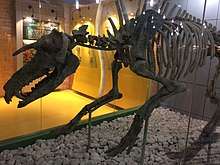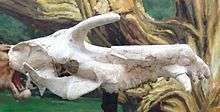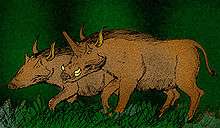Kubanochoerus
| Kubanochoerus | |
|---|---|
 | |
| Mounted skeleton of Kubanochoerus at the Beijing Museum of Natural History. | |
| Scientific classification | |
| Kingdom: | Animalia |
| Phylum: | Chordata |
| Class: | Mammalia |
| Order: | Artiodactyla |
| Family: | Suidae |
| Genus: | †Kubanochoerus Gabunia, 1955 |
| Species | |
| |
Kubanochoerus is an extinct genus of large and long-legged animals in the pig family from the Miocene of Eurasia.
Taxonomy

The genera Libycochoerus and Megalochoerus were once assigned to Kubanochoerus but are now considered distinct based on dental and minor cranial details.[1]
The putative paraceratheriid genus Caucasotherium, described from the Caucasus on the basis of a bone fragment with four incisors, is actually a synonym of the Middle Miocene Kubanochoerus gigas.[2]
Description

The largest species, the aptly named K. gigas, grew to be up 1.2 metres (3.9 ft) at the shoulder, and probably weighed up to 500 kilograms (1,100 lb) in life. The heads of these pigs were unmistakable, with small eyebrow horns, and a large horn emanating from the forehead of the males. It is speculated that the males used their forehead horns for jousting with each other.
References
- ↑ Bishop LC (2010) Suoidea. In: Werdelin L, Sanders WJ, editors. Cenozoic Mammals of Africa. Berkeley: University of California Press. pp. 821–842.
- ↑ PICKFORD, M., GABUNIA, L., MEIN, P., MORALES, J. & AZANZA, B. 2000. The Middle Miocene Mammalian site of Belometchetskaya, North Caucasus: an important biostratigraphic link between Europe and China. - Géobios 33 (2): 257-267, Lyon.